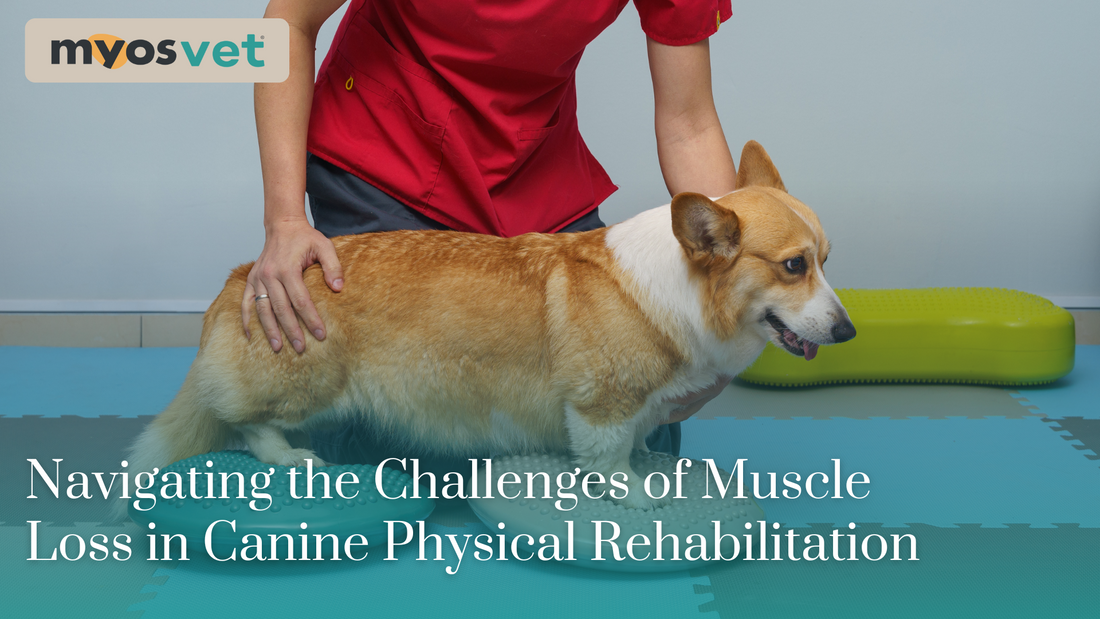
Navigating the Challenges of Muscle Loss in Canine Rehabilitation
Share
Canine rehabilitation veterinarians face a distinct set of challenges when treating patients with muscle loss caused by injury and reduced mobility. Whether the root issue is orthopedic or post-surgical, prolonged periods of inactivity can quickly lead to atrophy. This decline in muscle mass can delay recovery, impact mobility, and ultimately compromise quality of life—especially in older or working dogs.
In this blog, we’ll examine the hurdles rehabilitation specialists often encounter, and explore supportive strategies that can be implemented, including the integration of nutritional support like MYOS Canine Muscle Formula into a patient’s recovery plan.
The Vicious Cycle: Injury, Immobility, and Atrophy
Injured dogs often enter rehab having already experienced muscle loss, sometimes even before the injury is formally diagnosed. Reduced weight-bearing altered gait patterns, or post-surgical restrictions can trigger rapid atrophy—particularly in the hind limbs.
This muscle loss creates a domino effect:
- Decreased strength impairs mobility.
- Poor mobility increases risk of compensatory injuries.
- Delayed recovery leads to longer rehabilitation timelines.
Rehabilitation professionals are tasked with breaking this cycle—strengthening the patient without causing further stress to healing tissues.
Challenges in Rehab Due to Muscle Loss
1. Limited Load Tolerance:
Muscle weakness can limit how much a patient can tolerate therapeutic activities. Dogs may fatigue quickly or show signs of discomfort during basic exercises like sit-to-stand transitions or underwater treadmill sessions.
2. Asymmetry and Compensation:
Muscle imbalances often develop, leading to uneven loading and compensation in other limbs or joints. This not only complicates recovery but increases the risk of secondary injuries.
3. Age and Comorbidities:
Older patients recovering from injury often have slower healing responses and may also suffer from concurrent issues like osteoarthritis, making rebuilding muscle even more difficult.
4. Owner Compliance:
At-home exercise routines and follow-up care are essential, but ensuring consistency outside of the clinic can be a challenge.
Strengthening the Protocol: Strategies to Support Muscle Recovery
To effectively support muscle rebuilding in recovering dogs, rehab vets often combine a multifaceted approach that may include:
1. Progressive Therapeutic Exercise
Designing protocols that gradually increase resistance and intensity—starting with low-impact modalities and advancing to functional strengthening—ensures tissues aren’t overloaded prematurely.
2. Hydrotherapy
Water-based therapies allow for controlled, buoyant movement that builds muscle with minimal joint stress. It's particularly effective for dogs that can't yet support full body weight.
3. Neuromuscular Electrical Stimulation (NMES)
Used selectively, NMES can stimulate muscle contractions in atrophied areas to help slow or reverse muscle loss in patients unable to exercise effectively.
4. Targeted Nutrition for Muscle Health
Nutrition plays a vital role in supporting the rebuilding process. Muscle maintenance isn’t just about protein—specific nutrients and biologically active compounds can make a difference in recovery.
Where MYOS Canine Muscle Formula Fits In
MYOS Canine Muscle Formula, made with a single ingredient—Fortetropin® (a natural bioactive composition made from fertilized egg yolk)—has been shown in published research to support muscle health and reduce muscle atrophy. It can be a valuable addition to a rehabilitation protocol, particularly when muscle-building progress is slow or complicated by prolonged disuse.
Fortetropin is unique in that it supports the body’s natural muscle-building pathways while also helping to reduce the breakdown of existing muscle. This dual-action support can complement exercise-based rehab strategies and may be especially beneficial in:
- Post-operative recovery
- Dogs recovering from orthopedic injuries
- Senior dogs who struggle to regain strength
Importantly, MYOS Canine Muscle Formula is palatable, requires no prescription, and is easy to incorporate into daily feeding routines—making it a practical option for at-home compliance.
Conclusion
Rehabilitation professionals working with dogs affected by muscle loss face complex, multifactorial challenges that go beyond simply prescribing exercise. Success requires a strategic combination of movement, support, and nutrition. By integrating muscle-targeted nutritional support like MYOS Canine Muscle Formula into rehab protocols, veterinarians can offer a more comprehensive approach to recovery—helping dogs regain strength, mobility, and independence more efficiently.
